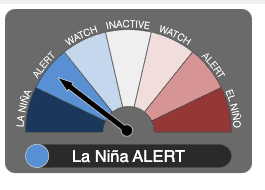One of our successful trades for Weather Wealth clients was buying December cotton several weeks ago on the historic Texas drought, lower U.S. crop ratings, and a rebound in the outside markets. You can see below in my report how my Spider was bullish on cotton a few weeks ago before the massive upward explosion in prices. Feel free to see our track record and different newsletters here https://www.bestweatherinc.com/weather-profits/.
We also have several successful soybean option strategies I recommended in the face of other meteorologists calling for doom and gloom heat and dryness a week or two ago, through the rest of August: Wrong!
But… will soybean and corn demand kick in after this grain sell-off? Is it possible corn and soybean yields will be lower, even in the midst of more rains coming to Iowa and the western corn belt? Will La Niña hold on this winter (south American summer) and mean a bull market in grains? If so, how do you play it? That is where we come in helping you sort through all the news and confusion out there.
At any rate, we recommended to our clients, after two limit-up moves, to take huge profits on Monday night. La Niña is alive and well and in contrast to some scientists and meteorologists out there, La Niña is NOT weakening and any talk of El Niño is ridiculous at this point. In fact, a new La Niña warning was just issued, something I have been suggesting since last spring.

While Texas only produces roughly 5-10% of the world’s cotton crop, a sharp reduction in cotton acreage was indeed confirmed by the USDA last Friday.
Notice how poor U.S. cotton crop conditions have been this summer due to La Niña.

This is why prices soared more than $12,000 a contract in three weeks until Wednesday’s profit-taking sell-off. The “anti-herd mentality” is a -3 currently (bearish) with too many people long the market. This Spider, however, was sent to clients nearly a month ago before the major move-up.


Earlier on Wednesday, I put out a new recommendation in cotton with a change in my Spider and prices collapsed. The reason: notice the drought easing rains predicted for Texas the next week or two with 150-300% of normal rainfall. Of course, these rains can not change the terrible abandoned acreage situation in Texas, but they will stabilize yields both in Texas and the Delta. Is this just a short-term reaction in an overall bull market?

Notice the rainfall forecast from Climate Predict (my in-house analytic software) for late August and September when La Niña is present. In contrast to typical hot, dry summer weather during La Niña events, the trend tends to be wetter in the fall. Part of this has to do with the hurricane season which typically is more active in the Gulf. In fact, we will be watching for one possible storm in the Gulf around August 28th. This may have impacts on energy, natural gas, and cotton trading, later on.

So… what is our longer-term view and how did we also call the easing of the western corn and soybean belt drought, very early, close to 10 days ago? What kind of strategy positions should you execute?
We invite you to a two-week complimentary trial subscription to Weather Wealthhere https://www.bestweatherinc.com/new-membership-options/
Thanks for your interest in commodity weather!
Warm regards,
The Weather Wealth team at www.bestweatherinc.com
- Please feel free to learn about Jim Roemer, our track record, and how we use weather to help traders around the world – J.S. Mathews, Editor
Mr. Roemer owns Best Weather Inc., offering weather-related blogs for commodity traders and farmers. The Weather Wealth blog, including both short-term and long-term forecasts and trading ideas, as well as Climatelligence, his monthly newsletter can be accessed at https://www.bestweatherinc.com/
He also is co-founder of Climate Predict, a detailed long-range global weather forecast tool. As one of the first meteorologists to become an NFA registered Commodity Trading Advisor, he has worked with major hedge funds, Midwest farmers, and individual traders for over 35 years. With a special emphasis on interpreting market psychology, coupled with his short and long-term trend forecasting in grains, softs, and the energy markets, he established a unique standing among advisors in the commodity risk management industry.












